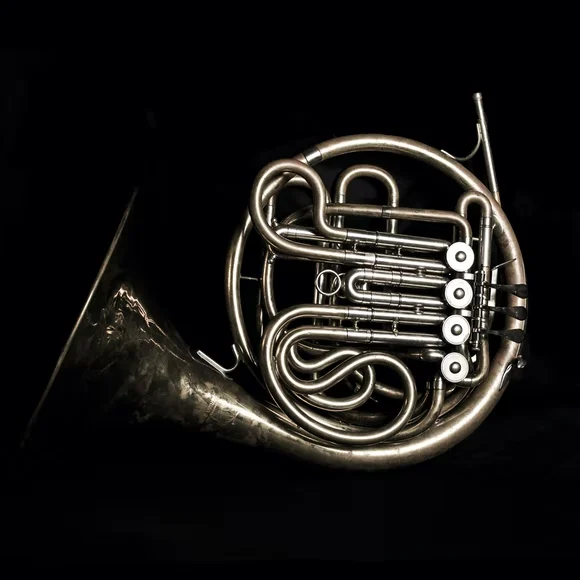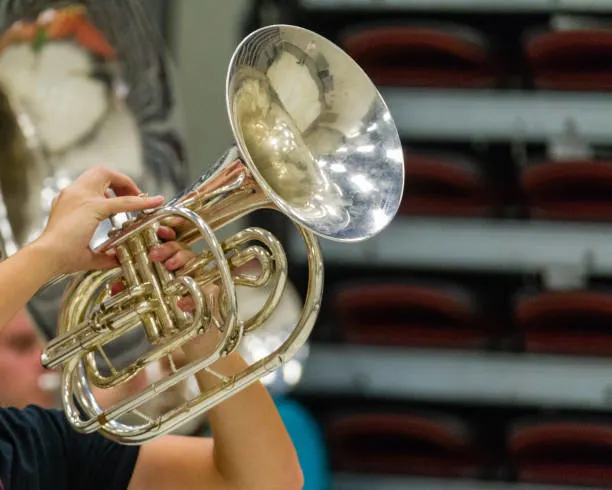Sometimes, you may wonder if there is any distinctive difference between a mellophone and a French horn or if are they wholly synonymous and used interchangeably with one another.
Well, the short answers are both yes and no; it depends entirely on the manufacturer and their classification of instruments. These two instruments are very similar, and it’s easy to see why people may mistake them for the other.
If you are someone who is confused between the two, I just have the right article for you. I’ll be discussing the key differences between the Mellophone and French Horn.
Please keep reading to know more.
What Kind of Instrument is a French Horn?

The French horn, which is also known as the horn, is an instrument made of brass tubing wrapped into a coil with a flared bell. The double horn in F/B♭ (technically a variety of German horns) is the horn most often used by professional orchestras and band players.
The French Horn is best known for its revolutionary role in classical music as well as the recent addition of it to classical jazz.
You would have surely seen the French horn in movies being used in fancy and eloquent settings.
What is Actually a Mellophone?

The mellophone is a brass instrument typically pitched in the key of F, although models in B♭, E♭, C, and G (as a bugle) have also historically existed. It also has a conical bore.
The mellophone is used as the middle-voiced brass instrument in marching bands, and drum, and bugle corps in lieu of French horns. It can also be used to play French horn parts in concert bands and orchestras. After all, they do sound quite similar to the ears of average individuals who aren’t well-versed in musical instruments.
These instruments are used instead of French horns for marching because their bells face forward rather than backwards. As the resonance of sound becomes a concern in the open-air environment of marching.
Fingerings for the mellophone are the same as fingerings for the trumpet, alto (tenor) horn, and most valved brass instruments. Because of its popularity outside concert music, their arent much solo literature for the mellophone when compared to the French horn, besides their usage within bugle and drum corps.
What’s the Difference between a French horn and a Mellophone?
The actual marching French Horns are used in the key of Bb and are the same length as the Bb side of a Bb/F double horn. The Bb side located at the double horn is used to play the instrument. The leaded pipe only accepts horn mouthpieces, as other mouthpieces can’t fit as perfectly.
A mellophone is in the key of F, as opposed to the Bb key used in French horns. It’s half the size of the F side of a double horn. It utilizes trumpet fingerings, and the leaded pipe accepts trumpet/flugelhorn mouthpieces.
A horn mouthpiece can be used with an adapter. So, that makes the mellophone more versatile.
The mouthpiece is different, especially the sound. The mellophone uses varying and distinctive mouthpieces (primarily something between a trumpet and a euphonium mouthpiece), and the marching French Horn uses a standard traditional Horn mouthpiece.
The F mellophone has tubing half the length of a French horn. This gives it an overtone series more similar to a trumpet and most other brass instruments. The slight mistakes and hiccups made when playing the mellophone are less pronounced when compared to the French horn.
Where Are They Used?
The marching mellophone is used in place of the horn for marching because it’s a bell-front instrument, allowing the projection of the sound only in the direction that the player is facing.
This is essential in drum corps. Marching bands, as the audience is usually on only one side of the band. Mellophones are made with a smaller bore for a louder volume than marching French horns.
Marching B♭ horns do utilize a horn mouthpiece and have a more French horn-like sound but are more difficult to play accurately on the field.
Aside from the usual marching setting, the traditional French horn is surprisingly omnipresent in a sense. In contrast, the mellophone is rarely used outside of marches and bands, though it can be used to play French horn parts in a concert band or orchestra.
Which is Easier?
Another factor in the greater use of mellophones is their ease compared to the difficulty of consistently playing the French horn well.
In a French horn, the length of the tubing and bore size make the partials. It’s much closer together than other similar brass instruments. Their normal sonorous range makes it harder to play as accurately.
In other words, the mellophone is an instrument intricately constructed to play the approximate sound of a horn in a package, which is useful when playing while marching.
Mellophones are essentially trumpets that have an elongated tube and a giant bell (or the main body of the instrument) that gives them more volume than what you would find in a conventional trumpet.
They’re pitched between a Bb and Eb, so they don’t require much effort on the lungs and the lips to breathe into as some other brass instruments do.
Which Should You Pick?
If you’re looking for something cheaper and louder, then this might not be the exact instrument to look for. However, if you want something that is easier to pick up and is more forgiving of mistakes while playing, then the mellophone is an excellent alternative to the French horn.
At the end of the day, they are both brass instruments. The main difference is that the French horn is used in orchestras or bands while marching bands and jazz bands play the mellophone.
If you are contemplating joining a band, then do know this: the French horn is one of the most challenging instruments to learn. But if you’re choosing to play in a marching band, then the mellophone isn’t that difficult to play and would be easier on the lips.
This YouTube video perfectly summarizes all the details I’ve covered. Have a look!
What’s the Difference in Price?
Although these two instruments are similar in many ways, they have completely different price ranges.
As French horns are more intricately crafted. They produce richer sounds. But they are, as expected, much more expensive than the mellophone.
This is precisely why many, recommend new players purchase the mellophone instead of the French Horn. This way, they can get well acquainted with these types of instruments without breaking the bank!
Here, I’ve included a data table below listing the prices for common brass instruments.
| Instrument | Price Range |
| Mellophone | Starting from $500-$2000 |
| French Horn | Starting from $1000-$6000 |
| Trumpet | Starting from $100-$4000 |
| Trombone | Starting from $400-$2800 |
| Tuba | Starting from $3500-$8000 |
How Difficult is the French Horn?
The French horn is notorious for its difficulty in playing it accurately. Why is that so?
The principal reason is that the horn has a distinctive 4.5-octave range, much more than any other wind or brass instrument. Playing all the right notes at the top of the series is very difficult.
When you play a note on the Horn, it resonates with overtones associated with the Harmonic series for that note. 1 note is phonetically 16 notes, so the player must tune in with the series and the other instruments, or it gets messy.
Horn players have excellent pitch because they can sense these overtones, and another player who is off the pitch will disrupt them.
One reason is the mouthpiece is relatively small compared to the other brass instruments. It requires a greater amount of finesse to play properly. Your formation has to be correct, or you will never be able to improve.
The French horn has double the length of tubing compared to the trumpet, tenor horn, or mellophone. This means that the notes on each valve combination are countless and fairly close together. It increases the possibility of mispitching, particularly in higher notes.
Compared to other mid-pitch brass, The French horn has a narrower and sharper mouthpiece. A thin bore in the mouthpiece causes the horn to be less stable to control.
Conclusion
Take note of the key information in this article:
- Mellophones and French Horns differ in construction, pitch, and usage.
- French Horns produce deeper tones and are pricier than Mellophones.
- Mellophones offer louder sounds and are easier to learn.
- French Horns have a challenging 4.5-octave scale.
- Mellophones shine in marching bands with forward-facing bells.
- French Horns are versatile across music genres. And Mellophones suit specific niches.
- French Horns cost more than Mellophones.
- The choice depends on skill level, budget, and musical preference.
You might be interested in:
WHAT IS THE DIFFERENCE BETWEEN A THRIFT STORE AND A GOODWILL STORE? (EXPLAINED)
WHAT IS THE DIFFERENCE BETWEEN MONTANA AND WYOMING? (EXPLAINED)

